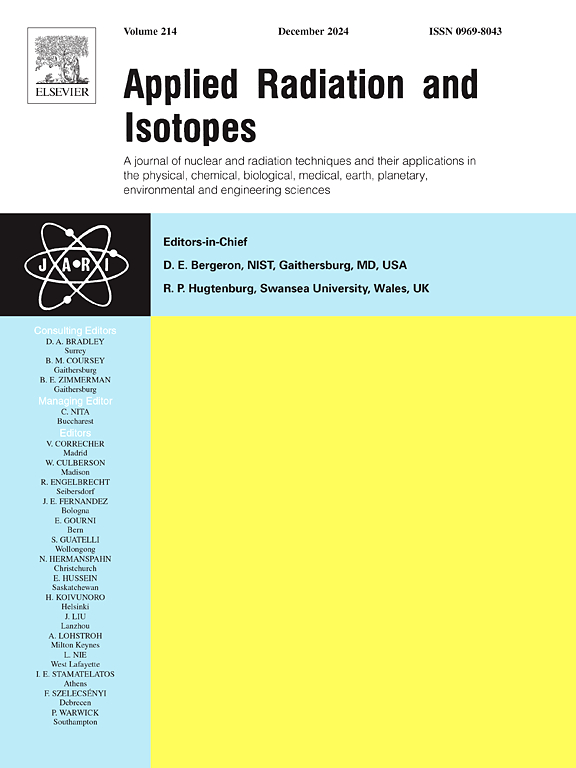p、α和重离子辐照钍和铀靶材产生225Ac和223Ra的截面预测
IF 1.8
3区 工程技术
Q3 CHEMISTRY, INORGANIC & NUCLEAR
引用次数: 0
摘要
本工作研究了用不同入射粒子轰击232Th和天然铀靶产生225Ac和223Ra的有效方法。通过高能质子轰击232Th直接生产225Ac不可避免地含有227Ac杂质,使分离和纯化过程复杂化。相反,通过产生225Ra获得225Ac可以避免227Ac污染。考虑到质子-钍反应产生225Ra的低截面,探索新的方法来提高225Ra的生产效率是至关重要的。本研究利用蒙特卡罗输运代码FLUKA和PHITS的几种物理模型,计算了钍和铀靶在10-800 MeV/u能量范围内,高能质子、α-粒子、9Be和12C轰击225Ac、225Ra、223Ra和227的生成截面。然后将预测截面与现有实验数据进行比较。预测结果表明,α-粒子和重离子辐照产生225Ac、225Ra和223Ra的能量阈值低于质子辐照,产生截面显著增大,峰值截面对应的入射能量主要在100 MeV/u以下。根据PHITS JQMD-2.0的结果,利用α-粒子轰击钍靶产生225Ra,进而获得高纯度的225Ac可能是一种有效的生产途径。当α-粒子能量低于100 MeV/u时,天然铀靶材的225Ra预测截面大于钍靶材,表明α-粒子轰击天然铀靶材可能是提高225Ac生产效率的新方法。该研究为后续实验截面测量和同位素生产提供了理论参考。本文章由计算机程序翻译,如有差异,请以英文原文为准。
Predictions of 225Ac and 223Ra production cross sections from p, α and heavy ion irradiated thorium and uranium targets
—This work studies effective methods for producing 225Ac and 223Ra by bombarding 232Th and natural uranium targets with different incident particles. Direct production of 225Ac via high-energy proton bombardment of 232Th inevitably contains 227Ac impurities, complicating the separation and purification processes. In contrast, obtaining 225Ac through the generated 225Ra can avoid 227Ac contamination. Given the low cross section for the proton-thorium reaction to produce 225Ra, exploring new methods to improve 225Ra production efficiency is critical. This study utilized several physical models of the Monte Carlo transport codes FLUKA and PHITS to calculate the production cross sections of 225Ac, 225Ra, 223Ra, and 227Th via the bombardment of thorium and uranium targets with energetic protons, α-particles, 9Be, and 12C across an energy range of 10–800 MeV/u. The predicted cross sections were then compared with existing experimental data. The predictions indicate that the energy thresholds to produce 225Ac, 225Ra, and 223Ra via α-particle and heavy ion irradiation are lower than those for proton, and the production cross sections are significantly increased, the incident energy corresponding to the peak cross section is mainly below 100 MeV/u. According to the PHITS JQMD-2.0 results, using α-particle bombardment of thorium targets to produce 225Ra and subsequently obtaining high-purity 225Ac may be an efficient production pathway. Moreover, when the α-particle energy is below 100 MeV/u, the predicted cross section of 225Ra for the natural uranium target is higher than that for the thorium target, suggesting that α-particle bombardment of the natural uranium target could be a potential new method to improve 225Ac production efficiency. This study provides theoretical reference for subsequent experimental cross section measurement and isotope production.
求助全文
通过发布文献求助,成功后即可免费获取论文全文。
去求助
来源期刊

Applied Radiation and Isotopes
工程技术-核科学技术
CiteScore
3.00
自引率
12.50%
发文量
406
审稿时长
13.5 months
期刊介绍:
Applied Radiation and Isotopes provides a high quality medium for the publication of substantial, original and scientific and technological papers on the development and peaceful application of nuclear, radiation and radionuclide techniques in chemistry, physics, biochemistry, biology, medicine, security, engineering and in the earth, planetary and environmental sciences, all including dosimetry. Nuclear techniques are defined in the broadest sense and both experimental and theoretical papers are welcome. They include the development and use of α- and β-particles, X-rays and γ-rays, neutrons and other nuclear particles and radiations from all sources, including radionuclides, synchrotron sources, cyclotrons and reactors and from the natural environment.
The journal aims to publish papers with significance to an international audience, containing substantial novelty and scientific impact. The Editors reserve the rights to reject, with or without external review, papers that do not meet these criteria.
Papers dealing with radiation processing, i.e., where radiation is used to bring about a biological, chemical or physical change in a material, should be directed to our sister journal Radiation Physics and Chemistry.
 求助内容:
求助内容: 应助结果提醒方式:
应助结果提醒方式:


